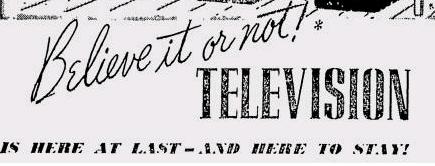 Seventy-five years ago, television looked like it was ready to take off, but it didn’t become a widespread reality until after the war. There had been experimental transmissions for a few decades, and by 1939, sets were being advertised. April 30, 1939, marks the day from which TV has been continually broadcast in the United States.
Seventy-five years ago, television looked like it was ready to take off, but it didn’t become a widespread reality until after the war. There had been experimental transmissions for a few decades, and by 1939, sets were being advertised. April 30, 1939, marks the day from which TV has been continually broadcast in the United States.
The Newark Sunday Call for that day contains at least three television advertisements. One is this ad for Wilderotter’s, which announces that “television becomes an actuality for the public today!” It announced a special 3-1/2 hour program to be telecast from the World’s Fair by NBC, featuring an address by president Roosevelt. It announces that the store will be open from noon until 1 P.M. on Sunday for the public to hear and see this special program. It also includes the NBC television schedule, which included programming on Wednesday and Friday from 4 P.M. to 9 P.M., “outdoor telecasts of news events” on Wednesday through Friday afternoons, and “film transmissions” on Monday, Tuesday, and Thursday from 11 A.M. to 4 P.M.
The Griffith Piano Company has this ad announcing that it, too was ready to put a television receiver in your home. The advertised prices ranged from $199.50 to $600.
Finally, Kresge’s Department Store announces that television “is here at last–and here to stay!”
Unlike earlier television system, these models were electronic. They used a system similar to postwar television, but were 441 lines. The station, then will the call sign W2XBS, remained on the air only until 1940 or 1941 in the original 441 line format. It received a commercial license in 1941, and became WNBT. But at that time, it began using what is usually call the “postwar” format of 525 lines. Some broadcasting continued during the war, but the station was used mostly by the New York Police Department for civil defense training. The station, now WNBC, does have the distinction of being the nation’s oldest continuously operating TV station. And it celebrates its 75th birthday on April 30, 2014.
So Kresge’s was correct in saying on April 30, 1939, that television was here to stay. But unfortunately for those who purchased a $600 set in 1939, the device became obsolete in two years with the switch to the 525 line format.

Pingback: The Boys from Boise (1944): TV’s First Musical | OneTubeRadio.com
Pingback: Two Lucky Winners, and Four Not Quite So Lucky | OneTubeRadio.com
Pingback: WNBT-TV New York, 1945 | OneTubeRadio.com
Pingback: Stratovision: Airborne TV Broadcasting | OneTubeRadio.com
The 1939 sets did NOT become obsolete. Although designed for 441 line transmission, in most cases, they worked perfectly (or with little adjustment) on the 525 line service.
There are a considerable amount of pre-war electronic sets from 1939-1941 which are in the hands of collectors and museums which work perfectly, even with a digital/analog converter box.
Pingback: 1947 TV Census | OneTubeRadio.com
Pingback: 1938 TV Images | OneTubeRadio.com
Pingback: American Television Turns 80 | OneTubeRadio.com